What to do with old yoga mat? Yoga mats are essential tools for any yoga practice, providing comfort, support, and stability during asanas and meditation. However, like any other item, yoga mats can wear out over time, lose their grip, or become damaged. Instead of tossing your old mat in the trash, consider repurposing it for other uses. In this article, we will explore 5 creative ways to reuse your old yoga mat.

Cushioning for Outdoor Furniture
If you have a worn-out yoga mat that is still thick and cushiony, consider using it to pad outdoor furniture. Cut the mat to fit the seat or back of your chairs, loveseats, or benches. This will provide extra comfort for outdoor gatherings and relaxation. The durable material of the yoga mat will also help protect your furniture from wear and tear, making it a practical and eco-friendly solution.
Protective Mat for Workspaces
Old yoga mats can be repurposed as protective mats for workspaces such as garages, workshops, and craft areas. Simply place the mat on the floor to provide cushioning and insulation while working on projects. The textured surface of the yoga mat can also help prevent tools and equipment from sliding around. This practical use of old yoga mats can help keep your floors clean and lessen the impact of heavy tools on hard surfaces.
Grip Pads for Opening Jars
If your old yoga mat still has some grip left, consider cutting it into small squares to use as grip pads for opening stubborn jars. The rubbery texture of the mat can provide extra traction, making it easier to twist and open jars with tight lids. This simple and clever use of old yoga mats can save you from the frustration of struggling to open jars and bottles in the kitchen.
Insulating Mat for Pets
If you have pets, old yoga mats can be repurposed as insulating mats for their sleeping areas. Cut the mat to fit the size of your pet’s bed or crate and place it underneath as an added layer of comfort and warmth. The insulating properties of the yoga mat can help keep your furry friends cozy during colder months and provide a softer surface for them to rest on. This eco-friendly alternative to traditional pet bedding can also save you money and reduce waste.

DIY Plant Pot Coasters
Old yoga mats can be transformed into DIY plant pot coasters to protect your floors and surfaces from water damage. Cut the yoga mat into circles or squares that are slightly larger than the base of your plant pots. Place the coasters underneath the pots to catch excess water and prevent it from seeping onto your floors or leaving unsightly water stains. The waterproof and durable nature of yoga mats makes them ideal for this purpose, and you can customize the coasters with decorative patterns if desired.
How to clean a yoga mat
Yoga is a wonderful way to stay fit, relax, and find balance. However, one often overlooked aspect of yoga is the cleanliness of your mat. Regular cleaning of your yoga mat is important to prevent bacteria, mold, and odors from building up.
Daily Maintenance
-
Wipe Down After Each Use
After each yoga session, take a moment to wipe down your mat with a damp cloth or a yoga mat spray. This will remove any sweat, oils, and dirt that may have accumulated during your practice. It’s a quick and easy way to keep your mat looking and feeling fresh.
-
Air Dry
After wiping down your mat, allow it to air dry before rolling it up. Hang it over a railing or lay it flat on the ground in a well-ventilated area. This will help prevent moisture from getting trapped in the mat and creating a breeding ground for bacteria.
Weekly Cleaning
-
Hand Wash with Mild Detergent
Once a week, give your yoga mat a thorough hand wash using a mild detergent. Fill a large basin or bathtub with warm water and add a small amount of mild detergent. Gently scrub the mat with a soft brush or sponge, paying extra attention to any areas that are particularly dirty or sweaty.
-
Rinse Thoroughly
After scrubbing, rinse the mat thoroughly with clean water to remove any soap residue. Ensure that all the soap is completely washed away, as leftover soap can make the mat slippery during your practice.
-
Air Dry
After rinsing, lay the mat flat on the ground or hang it up to air dry. Avoid using a dryer, as high heat can damage the material of the mat. Once it’s completely dry, roll it up and store it in a clean, dry place.

Deep Cleaning
If your yoga mat has developed a stubborn odor or has visible stains, it may be time for a deep cleaning. Here are a few methods for deep cleaning your yoga mat:
-
Vinegar Solution
Mix equal parts water and white vinegar in a spray bottle. Spray the solution onto the mat and let it sit for a few minutes. Then, use a damp cloth to wipe the mat clean. The acidity of the vinegar will help to kill bacteria and neutralize odors.
-
Baking Soda
Sprinkle a thin layer of baking soda over the surface of the mat and let it sit for 10-15 minutes. Then, use a damp cloth to scrub the mat, focusing on any areas with stains or odors. Rinse the mat thoroughly with clean water and allow it to air dry.
-
Tea Tree Oil
Tea tree oil is known for its antimicrobial properties, making it a great natural cleaner for your yoga mat. Mix a few drops of tea tree oil with water in a spray bottle and lightly mist the mat. Wipe it down with a clean cloth and allow it to air dry.
Tips for Keeping Your Yoga Mat Clean
In addition to regular cleaning, there are a few simple tips to help keep your yoga mat clean and fresh:
-
Use a Towel
Consider using a yoga towel or small hand towel on top of your mat during practice. This will help absorb sweat and prevent it from seeping into the mat.
-
Store Properly
When not in use, store your yoga mat in a cool, dry place away from direct sunlight. Avoid leaving it in a hot car or other areas where it may be exposed to extreme temperatures.
-
Rotate Your Mat
If you practice yoga frequently, consider rotating between two mats to allow each one to air out and dry thoroughly between uses.
By following these cleaning tips and practices, you can ensure that your yoga mat remains clean, hygienic, and free from odor. A clean yoga mat will not only enhance your practice but also contribute to a healthier and more enjoyable yoga experience.

Conclusion
Instead of discarding your old yoga mat, consider repurposing it for one of the creative uses mentioned above. By giving your yoga mat a second life, you can reduce waste and contribute to a more sustainable lifestyle. Whether you choose to transform it into a cozy cushion for outdoor furniture, a protective mat for workspaces, or a pot coaster for your plants, there are plenty of opportunities to give new purpose to your old yoga mat. With a little creativity and ingenuity, you can turn your worn-out yoga mat into a useful and eco-friendly resource.
